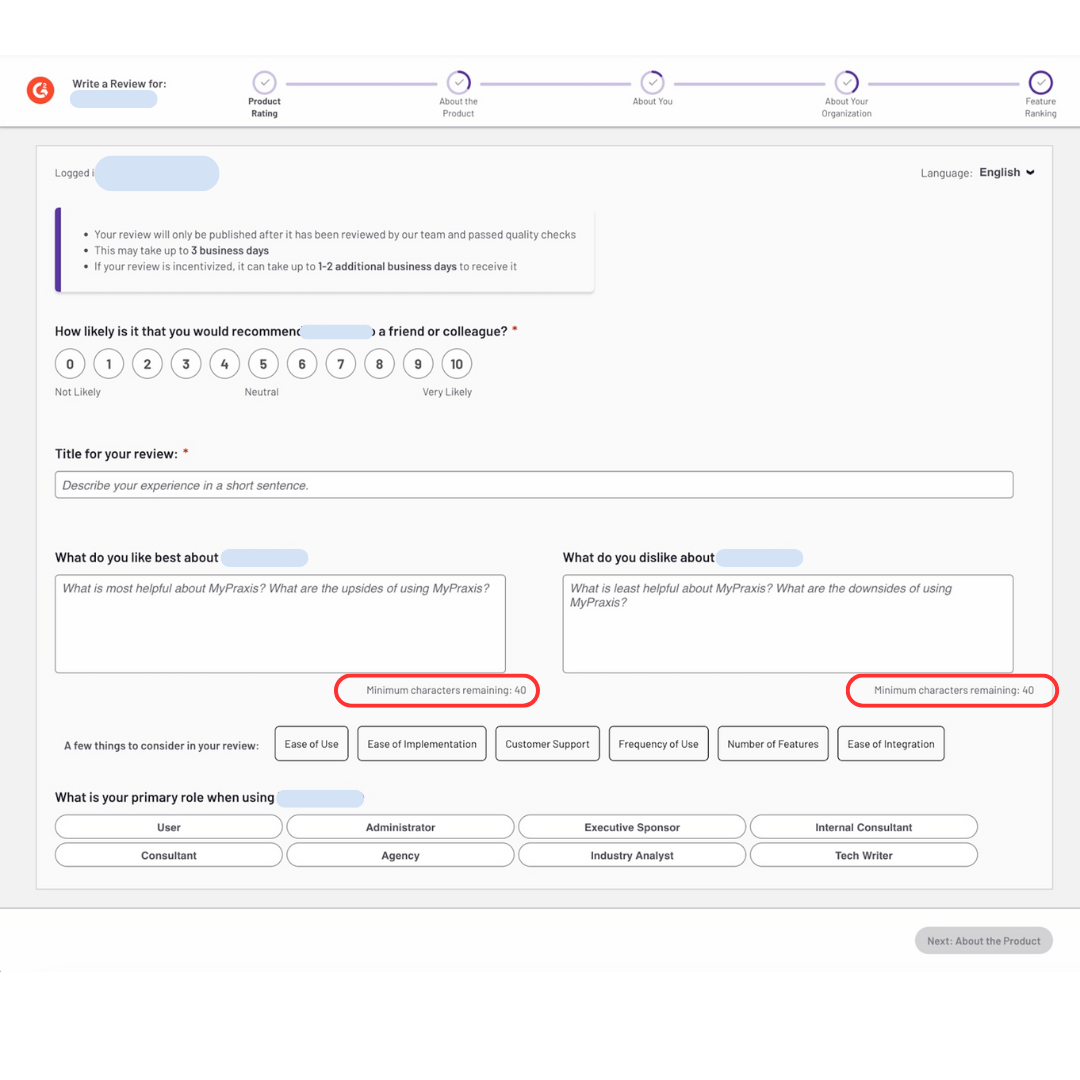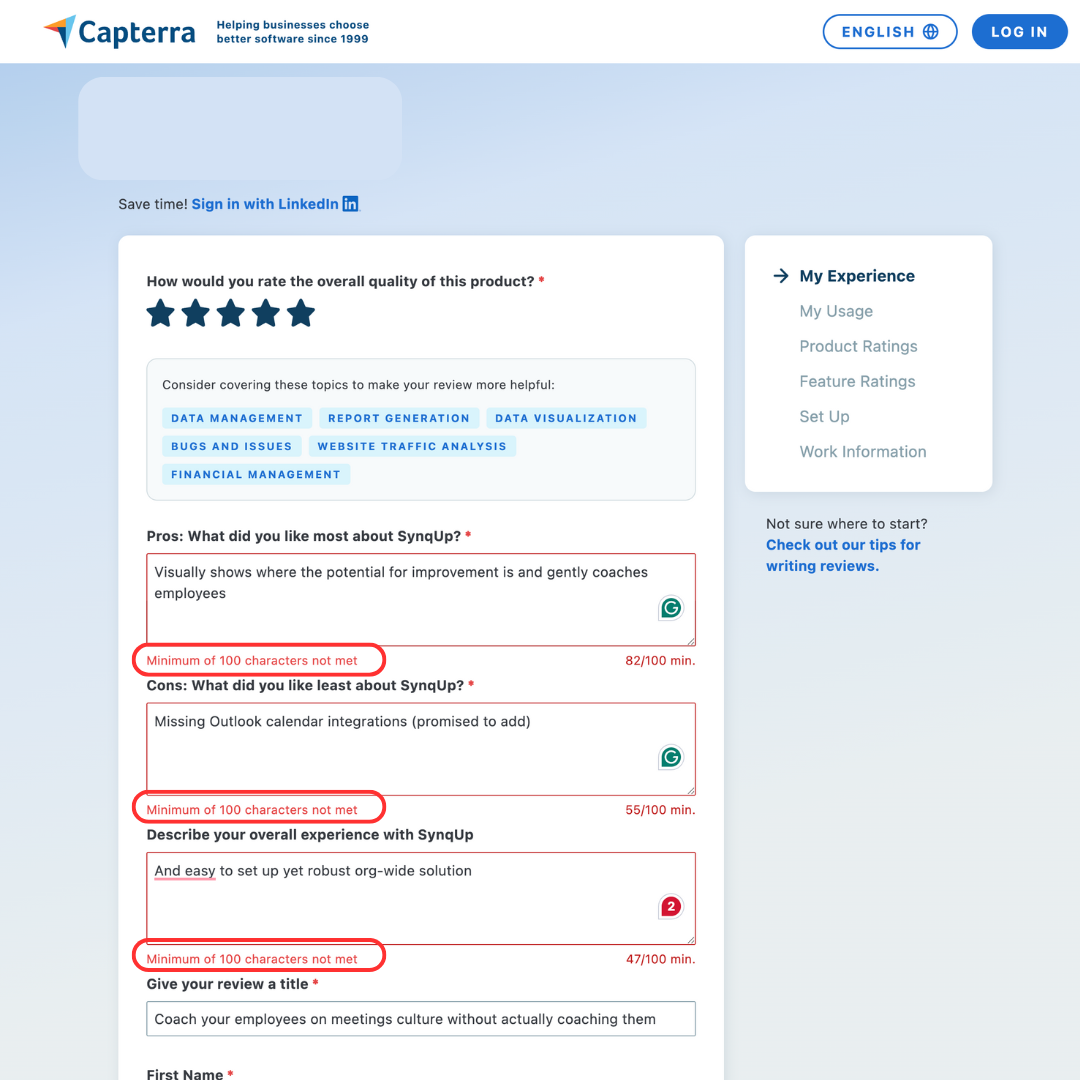B2B software buyers use G2 and Capterra as key touchpoints when researching software. AI tools increasingly reference these platforms when users ask for software recommendations—understanding how AI discovery shapes B2B software visibility is now essential. Star ratings and what customers actually say in reviews make an impact on purchase decisions. We can't measure the exact influence, but we know it works. Getting quality reviews on these platforms requires understanding their specific requirements and processes. At Blastra, we see that consistent, updated directory profiles amplify the impact of high-quality reviews across G2, Capterra, and other software discovery platforms.
 G2 review form interface showing the comprehensive feedback system. Source: G2.com
G2 review form interface showing the comprehensive feedback system. Source: G2.com
Understanding the Review Process
Both G2 and Capterra take review authenticity seriously, implementing verification processes that typically take 3-5 days for approval. The time investment for customers is significant — each review takes 10-15 minutes to complete properly — so it's crucial to understand exactly what's required.
Verification Requirements
Both Platforms:
- Corporate email verification or LinkedIn profile connection
- Manual review process with 3-5 day approval time
- Identity verification to prevent fake reviews
G2 Specific:
- Screenshot requirement showing the user logged into your product
- More stringent verification process
- Optional voice review feature (though this remains unreliable as of 2025)
Capterra Specific:
- No screenshot requirement
- Slightly streamlined verification process
- Integration with other Gartner Digital Markets properties
Platform Integrity Measures
Both platforms watch review quality carefully to prevent companies from gaming the system, and they really put effort into not approving fabricated reviews. However, there's a whole industry of people who make a business out of writing fake reviews and earning incentives by giving reviews across multiple platforms.
As a result, reviews from generic email addresses like Gmail are unlikely to be approved, as platforms prioritize corporate email verification. We do not recommend trying to pay for fake reviews, as this can damage your reputation on these platforms and potentially get your company profile flagged or suspended.
Essential Review Components to Prepare
The most time-consuming part of the review process involves the written sections that require thoughtful responses. Here's what your customers need to prepare:
Review Title
Both platforms require a short sentence summarizing the customer's experience. This appears prominently and often determines whether prospects read the full review.
What You Liked Most
- G2: Minimum 40 characters
- Capterra: Minimum 100 characters
This section should highlight specific features, benefits, or outcomes that made the biggest positive impact on the user's work or business.
What You Liked Least
- G2: Minimum 40 characters
- Capterra: Minimum 100 characters
Even satisfied customers usually have constructive feedback. This section actually builds credibility when handled thoughtfully — no software is perfect, and honest critiques make reviews more trustworthy.
Overall Experience
- G2: Minimum 40 characters
- Capterra: Minimum 100 characters
This is the opportunity for customers to provide a comprehensive summary of their experience, often touching on implementation, support, results achieved, and whether they'd recommend the software.
 Capterra's review form requiring detailed responses across multiple categories. Source: Capterra.com
Capterra's review form requiring detailed responses across multiple categories. Source: Capterra.com
The AI Factor: Immediate Impact with Fewer Reviews
While both G2 and Capterra rely on quantity and recency of reviews when rating products (both platforms prefer at least 10 reviews for optimal visibility), tests we've conducted on AI engines suggest that LLMs do not take this threshold into account as of September 2025. Even if you have just 1-2 reviews, AI chatbots and language models may still quote them when users ask for software recommendations.
This means the impact of reviews can be immediate. Your first few reviews may start influencing purchase decisions through AI-powered research tools before you've built up the volume that traditional platform algorithms prefer.
Strategic Advice for Getting Reviews
Timing Matters
The best time to request reviews is immediately after a customer achieves a significant win with your product — whether that's completing implementation, reaching a milestone, or seeing measurable results. Strike while the positive experience is fresh.
Make It Easy
Since reviews require significant time investment, remove as many barriers as possible:
- Provide direct links to the review forms
- Offer to help customers prepare their responses
- Send reminder emails if needed
- Consider the character minimums when guiding customers on response length
Remember that leaving a comprehensive review is a massive effort for any customer. If your users are C-level executives, they should be hand-held through the entire process — and no $25 gift card will motivate them to complete reviews. For these high-value reviewers, personal outreach, offering to draft initial responses for their approval, or even scheduling brief calls to gather their thoughts can be far more effective.
Incentivization Options
Both platforms offer ways to incentivize reviews:
- G2: Paid review campaigns available through your vendor account
- Capterra: Incentivized review campaigns offering up to $25 gift cards for approved reviews
Remember that incentives should be offered for the act of reviewing, not for positive sentiment — both platforms are transparent about this distinction to maintain review integrity.
Prepare Your Customers
Help your customers succeed by preparing them for the process:
- Explain the verification requirements upfront
- Let them know about the 3-5 day approval timeline
- For G2 reviews, remind them to have a screenshot ready showing them logged into your product
- Share the character minimums so they can prepare thoughtful responses
Conversion Reality: Why Handholding Matters
While there's no official industry benchmarking on review conversion rates, a Capterra representative once mentioned on a call that they typically see around 1% conversion from requests to completed reviews. This low conversion rate means if you want reviews, you should really focus on handholding your customers through the entire process rather than simply sending review requests.
Don't Forget to Respond
Once you have reviews, don't forget to respond to them. Engaging with reviewers shows prospects that you're actively involved with your customer community and care about feedback, whether positive or constructive. Keeping your directory and profile data consistent reinforces your review responses and improves buyer trust.
Capterra's Extended Reach
A huge benefit of Capterra reviews is that they syndicate across Gartner's other properties, including GetApp and Software Advice. This means your reviews get additional exposure across multiple high-traffic software discovery platforms without any extra effort on your part.
Quality Over Quantity
While review volume matters for visibility and ranking algorithms, quality reviews that provide specific details about use cases, implementations, and results are far more valuable for potential buyers. A detailed review from a customer in the prospect's industry discussing relevant challenges and outcomes will influence purchase decisions more than dozens of generic positive reviews.
Focus on encouraging your most engaged, articulate customers to leave reviews rather than trying to maximize the total number of reviews from every customer.
Key Takeaways
- Verification is strict: Both platforms require corporate email or LinkedIn verification with 3-5 day approval times
- AI amplifies impact: Even 1-2 reviews can influence AI-powered recommendations immediately
- Handholding is essential: With only 1% conversion rates, personal assistance dramatically improves success
- Quality beats quantity: Detailed, industry-specific reviews influence decisions more than generic praise
- Capterra multiplies reach: Reviews syndicate across GetApp and Software Advice automatically
Understanding and respecting these platforms' review processes while providing excellent customer support throughout the review journey will help you build a strong presence on G2 and Capterra that drives real business results. This review strategy is a key component of building a lasting competitive advantage through directory presence.
FAQ: Answers to Common Questions
Why do G2 reviews require screenshots?
G2 uses screenshots as a verification method to confirm the reviewer actually uses your product. The screenshot should show the user logged into your software. This requirement helps maintain review integrity and prevents fake reviews. Capterra doesn't require screenshots, making their process slightly simpler.
How long does review approval take?
Both platforms typically take 3-5 days to approve reviews. Reviews go through a manual verification process that checks identity, corporate email authenticity, and content quality. Plan for this timeline when running review campaigns—if you need reviews before a quarterly report deadline, start your campaign at least two weeks early.
Can customers leave reviews from personal Gmail addresses?
Reviews from generic email addresses like Gmail are unlikely to be approved. Both platforms prioritize corporate email verification to prevent fake reviews. If your customers use your product with personal emails, they can alternatively verify via LinkedIn profile connection.
What's the minimum character count for G2 vs Capterra reviews?
G2 requires minimum 40 characters for each section (What You Liked Most, What You Liked Least, Overall Experience). Capterra requires 100 characters minimum per section. Capterra's longer requirements mean reviewers need more preparation time, but the resulting reviews tend to be more substantive.
How do I get C-level executives to leave reviews?
Gift cards won't motivate busy executives. Instead, offer personal assistance: schedule a brief call to gather their thoughts, draft the review for their approval, or have their assistant handle the process. The key is removing friction—executives value their time, so make the process as effortless as possible.
You Might Also Like
- How to Get Ranked on G2: A Complete Technical Guide - Deep dive into G2's ranking algorithm and specific strategies to improve your position
- G2 Competitor Strategy: The Power of Strategic Claiming - Learn how to leverage competitor listings and comparison pages for your advantage
- Directory Strategy as Competitive Moat - Build an enduring advantage through systematic directory presence
Use Blastra to submit your business to relevant software directories and manage your listings.

